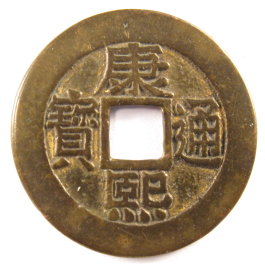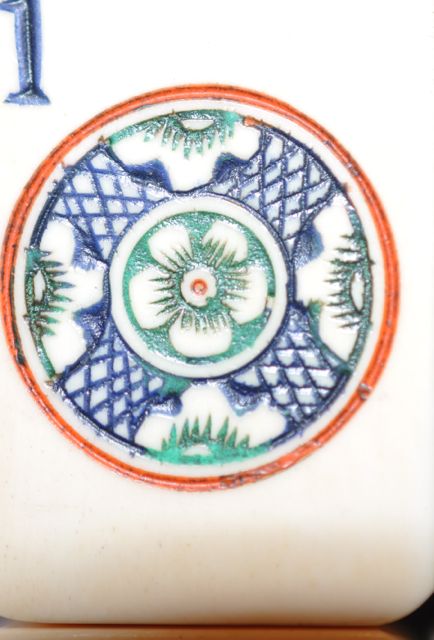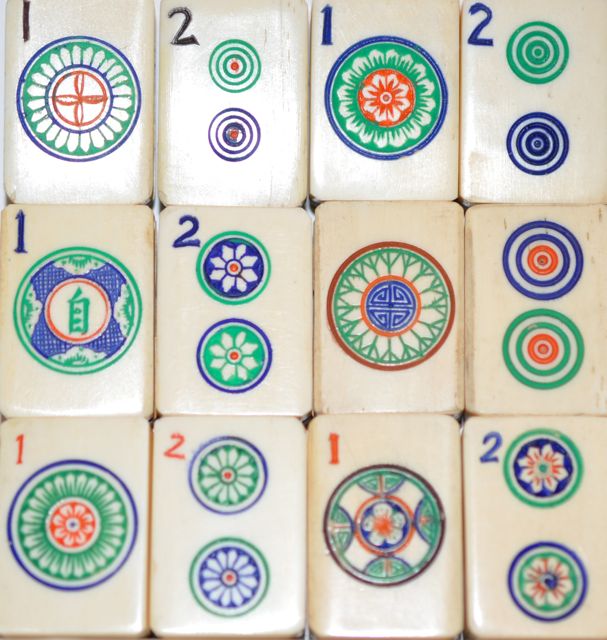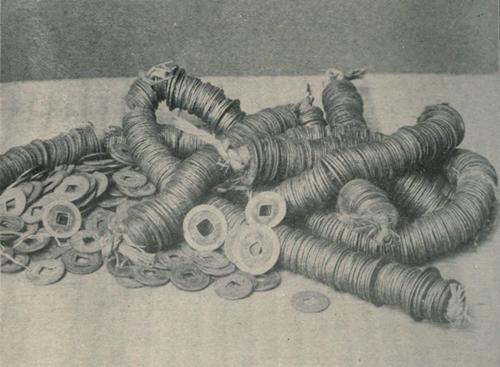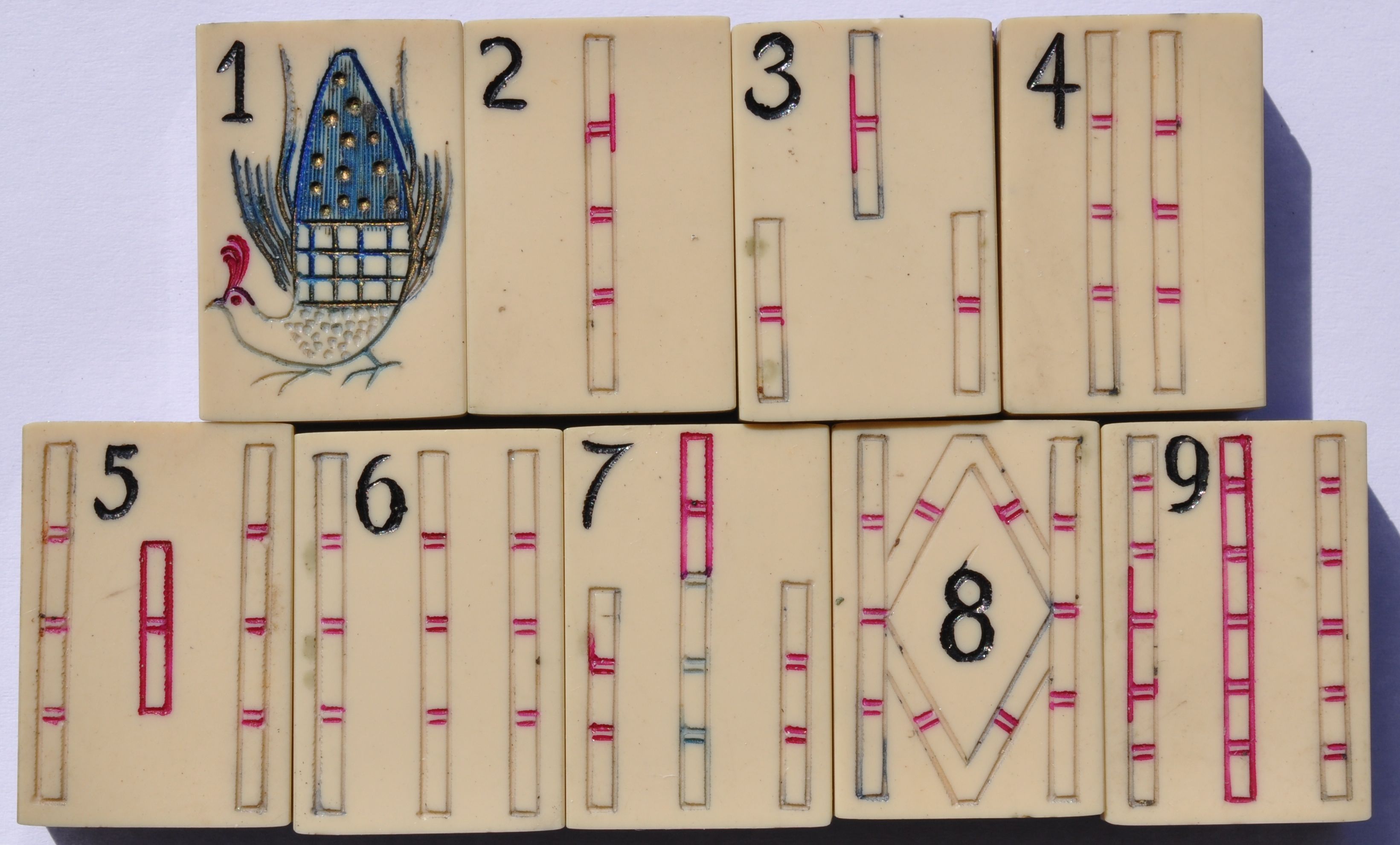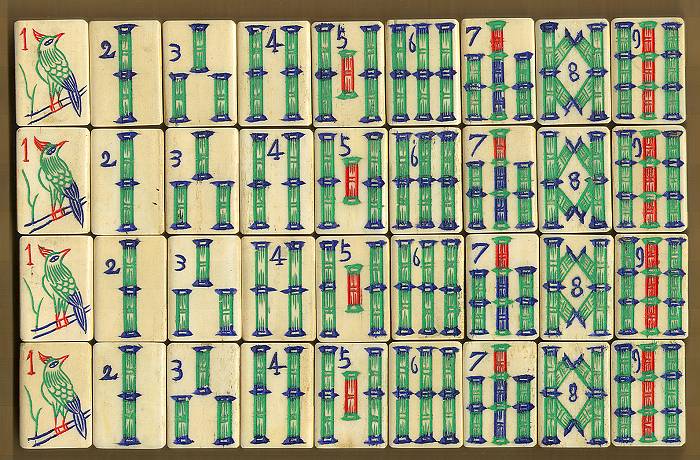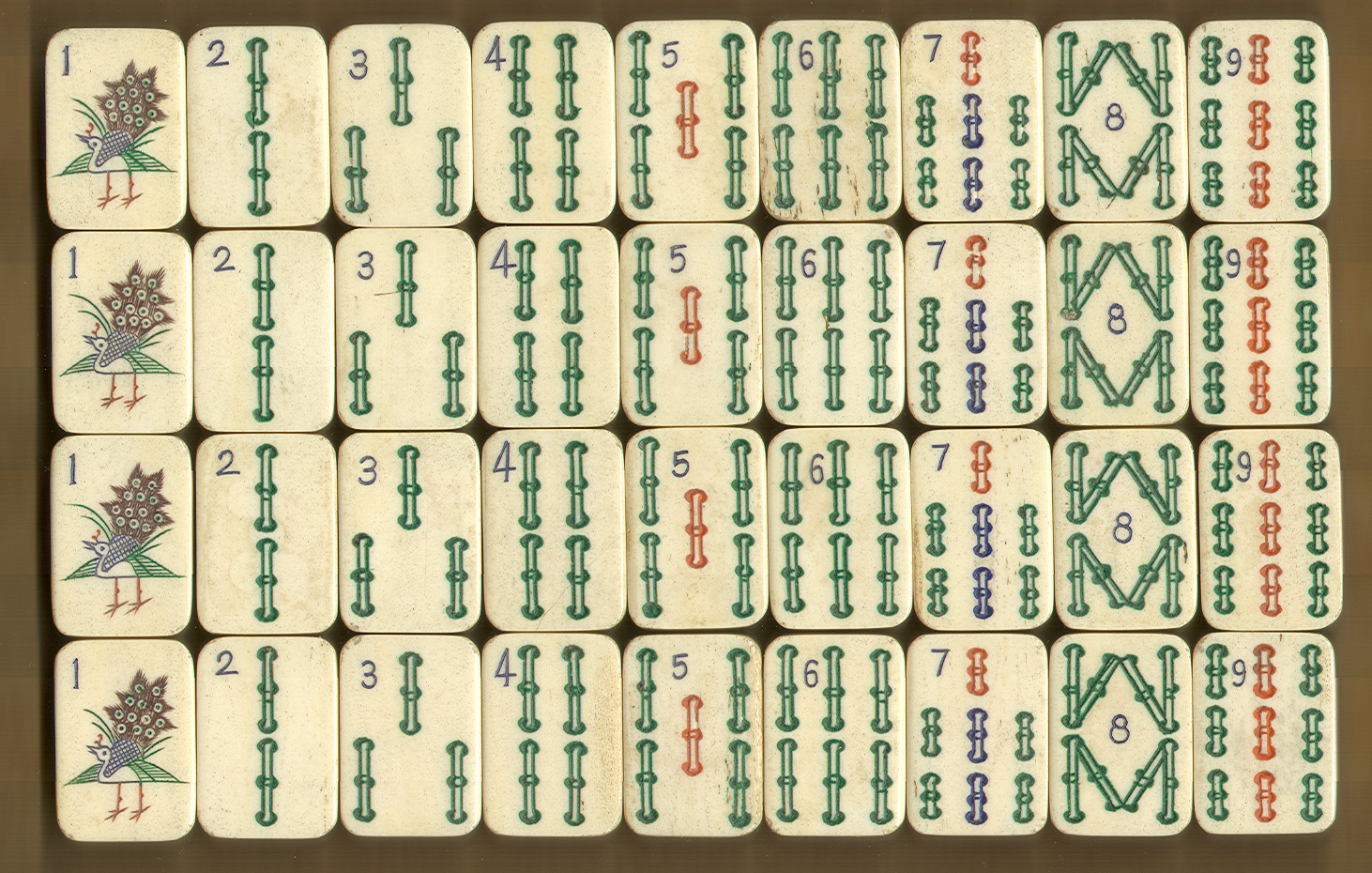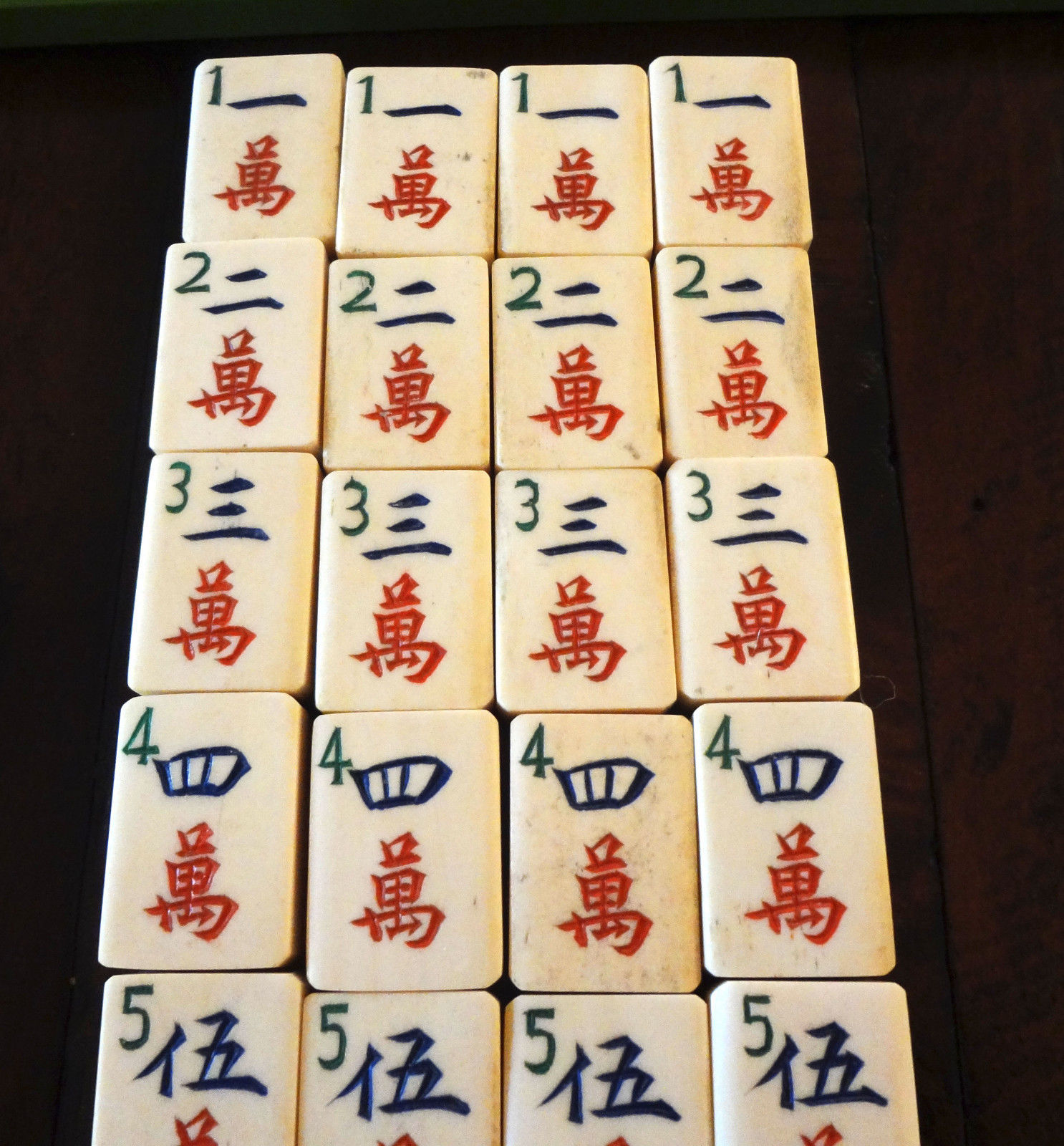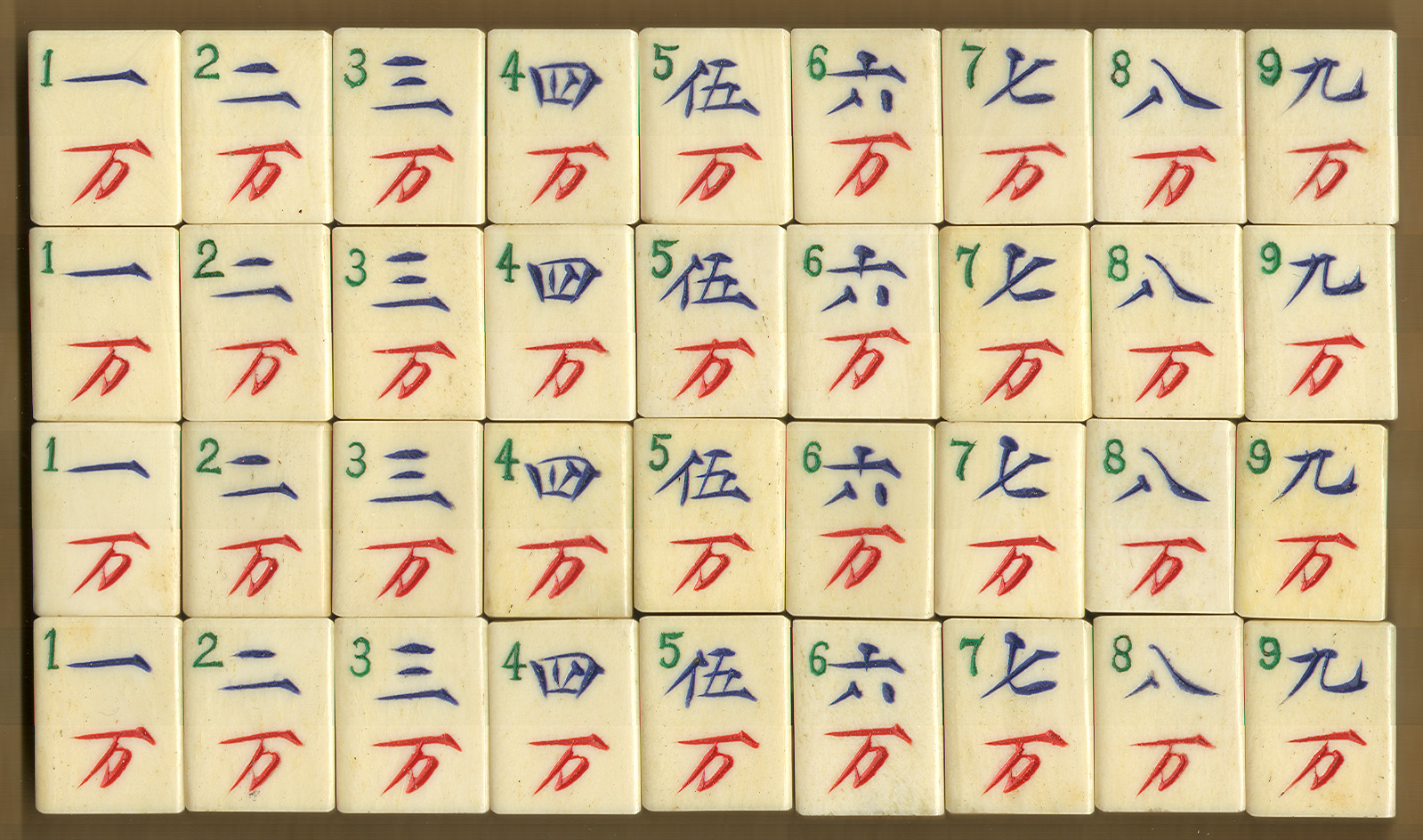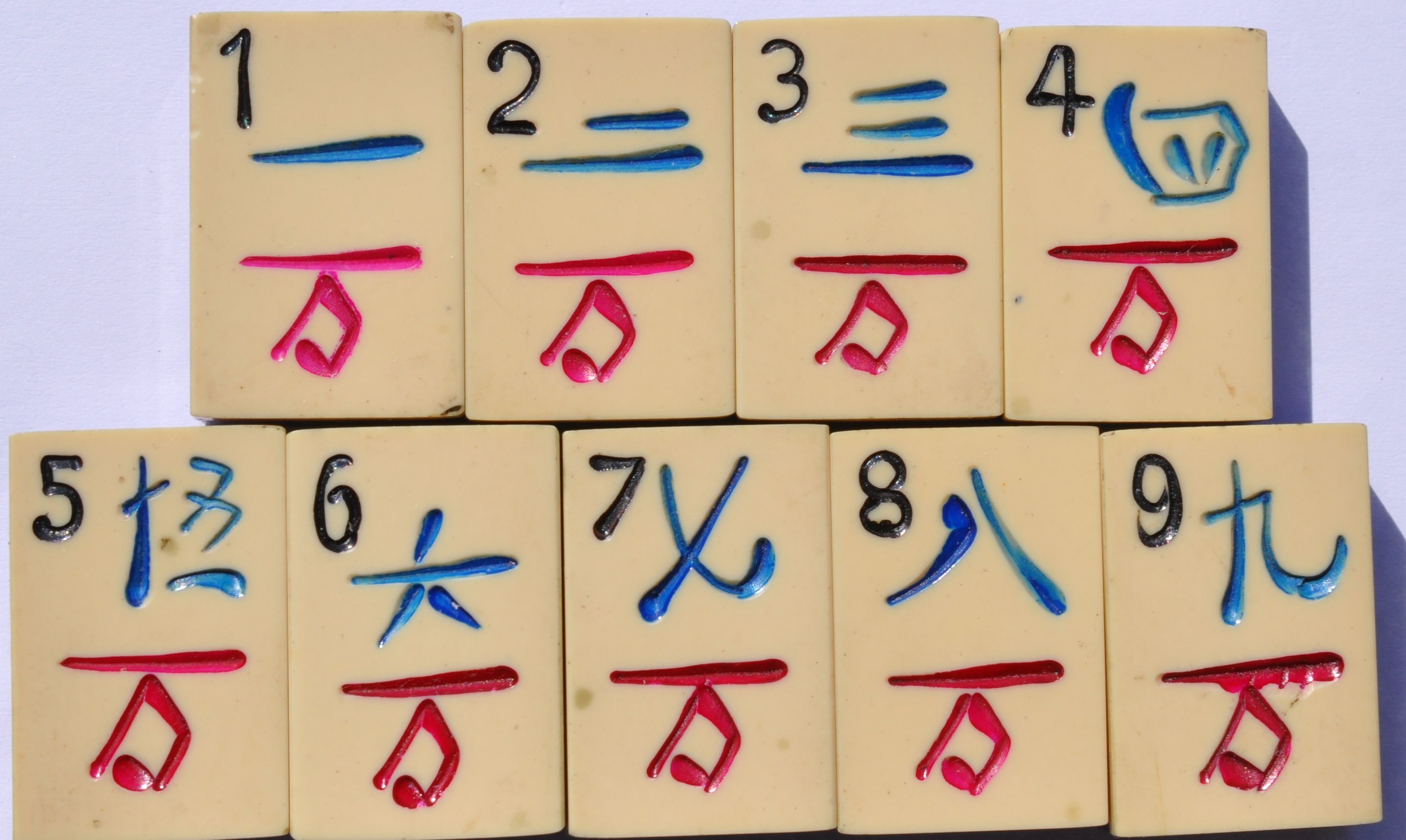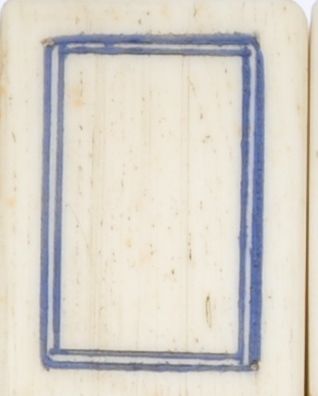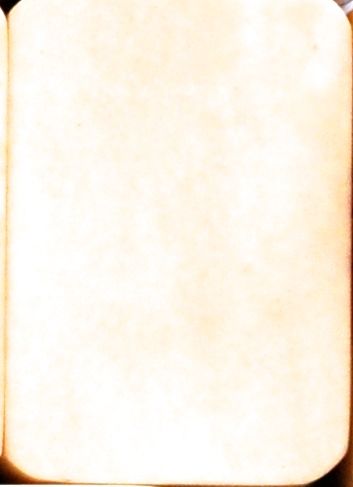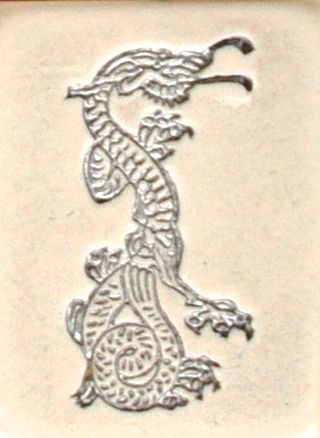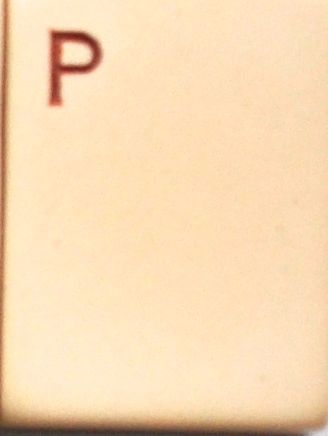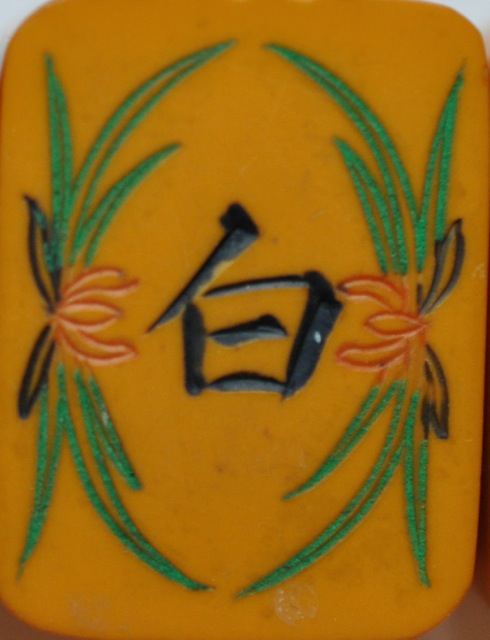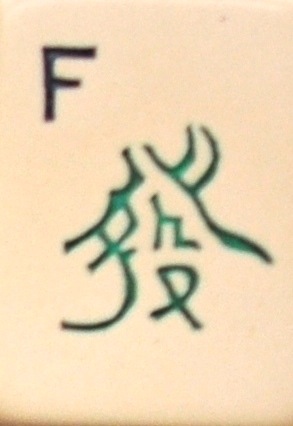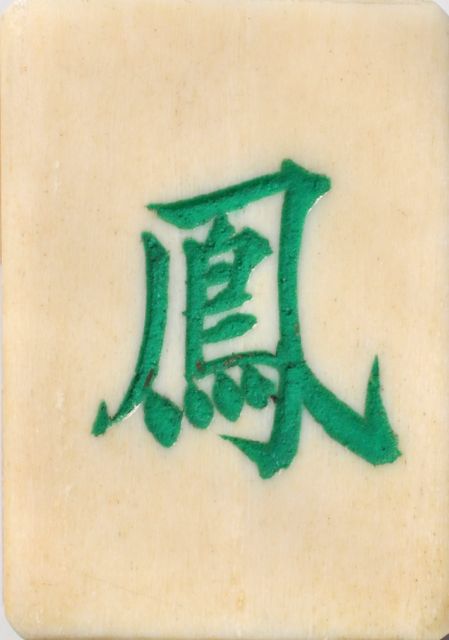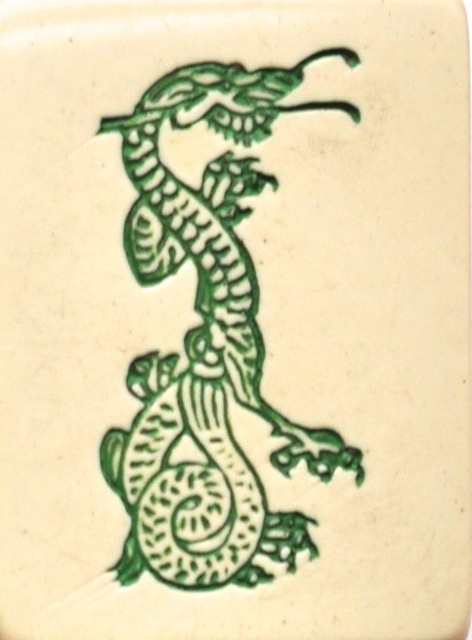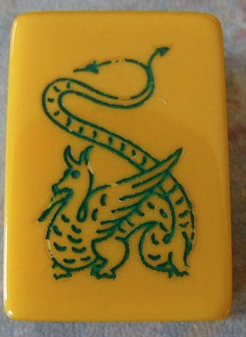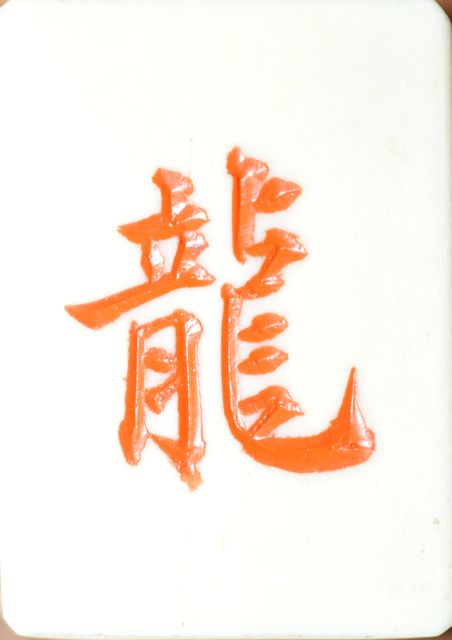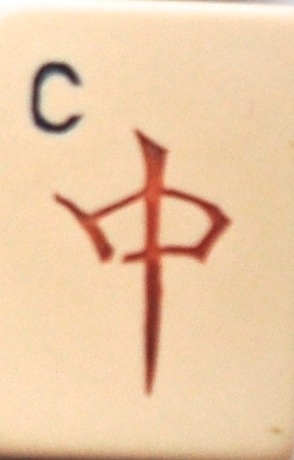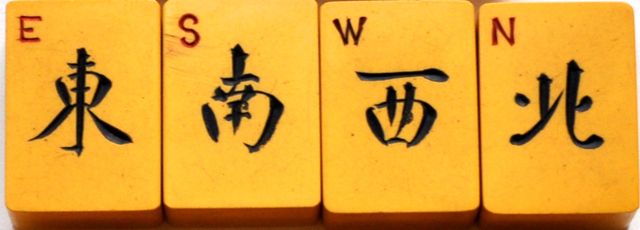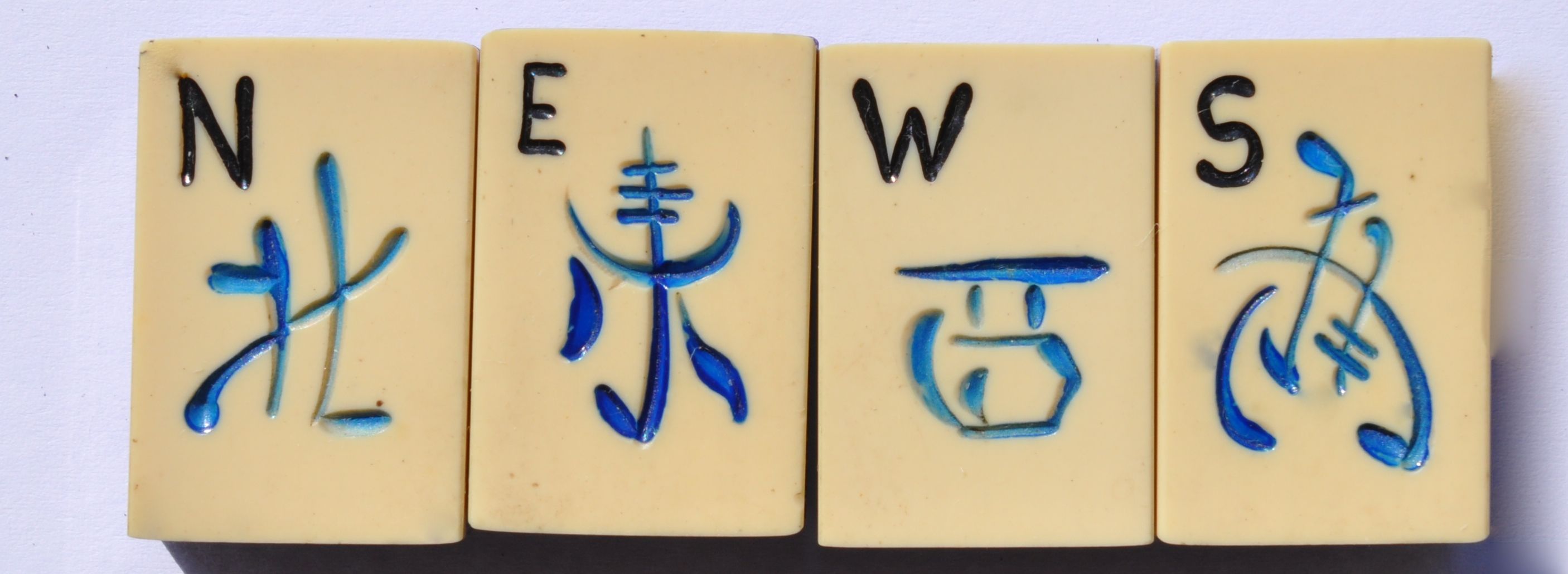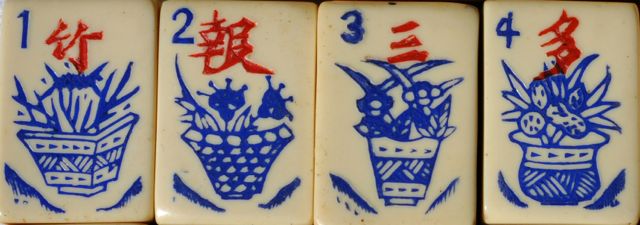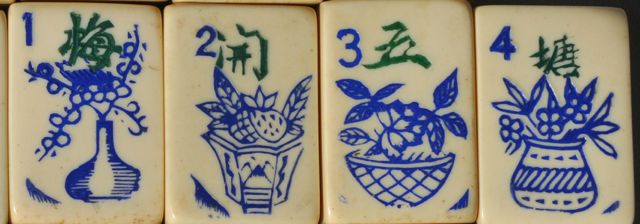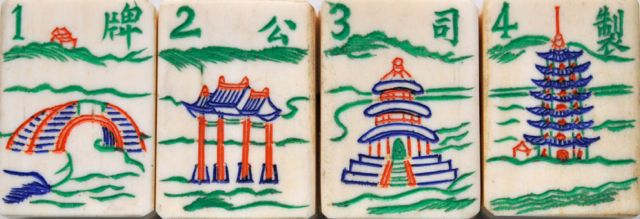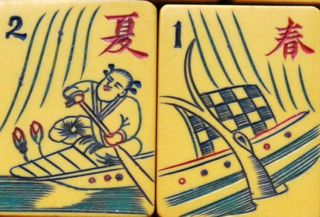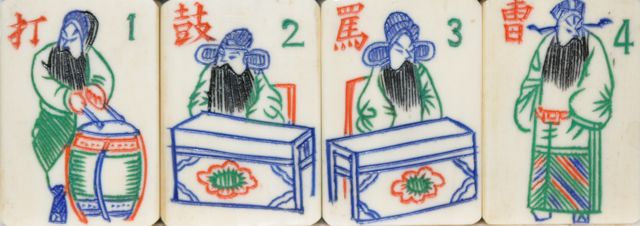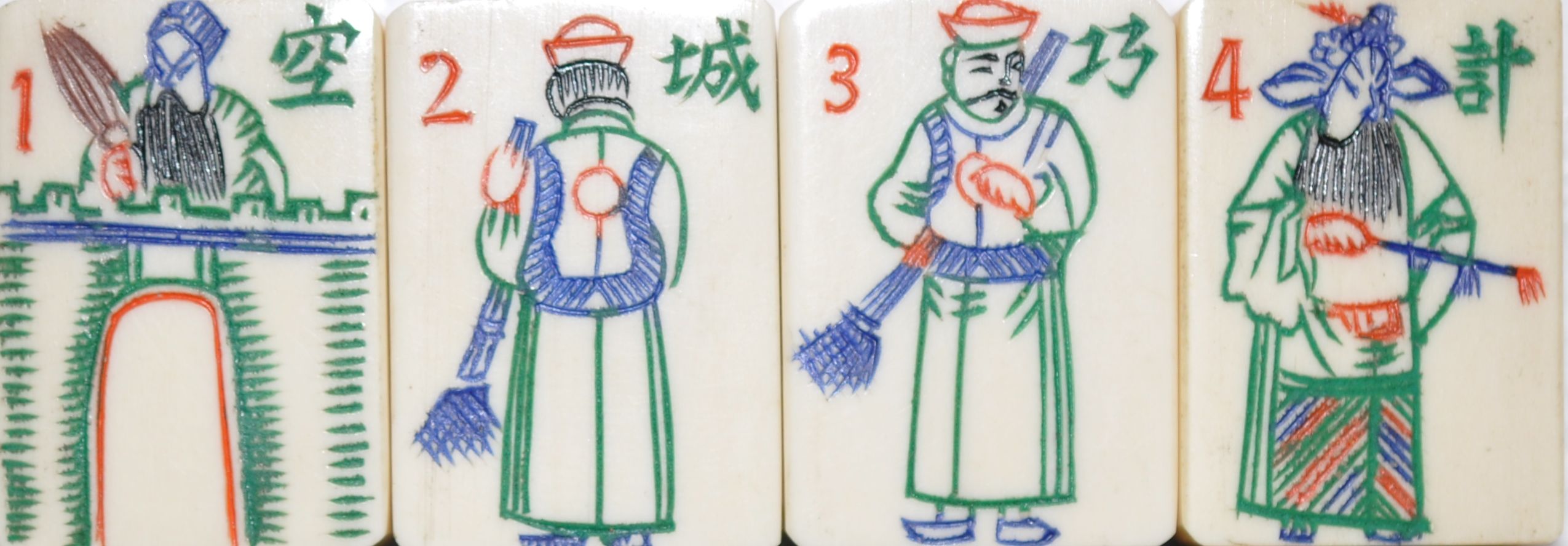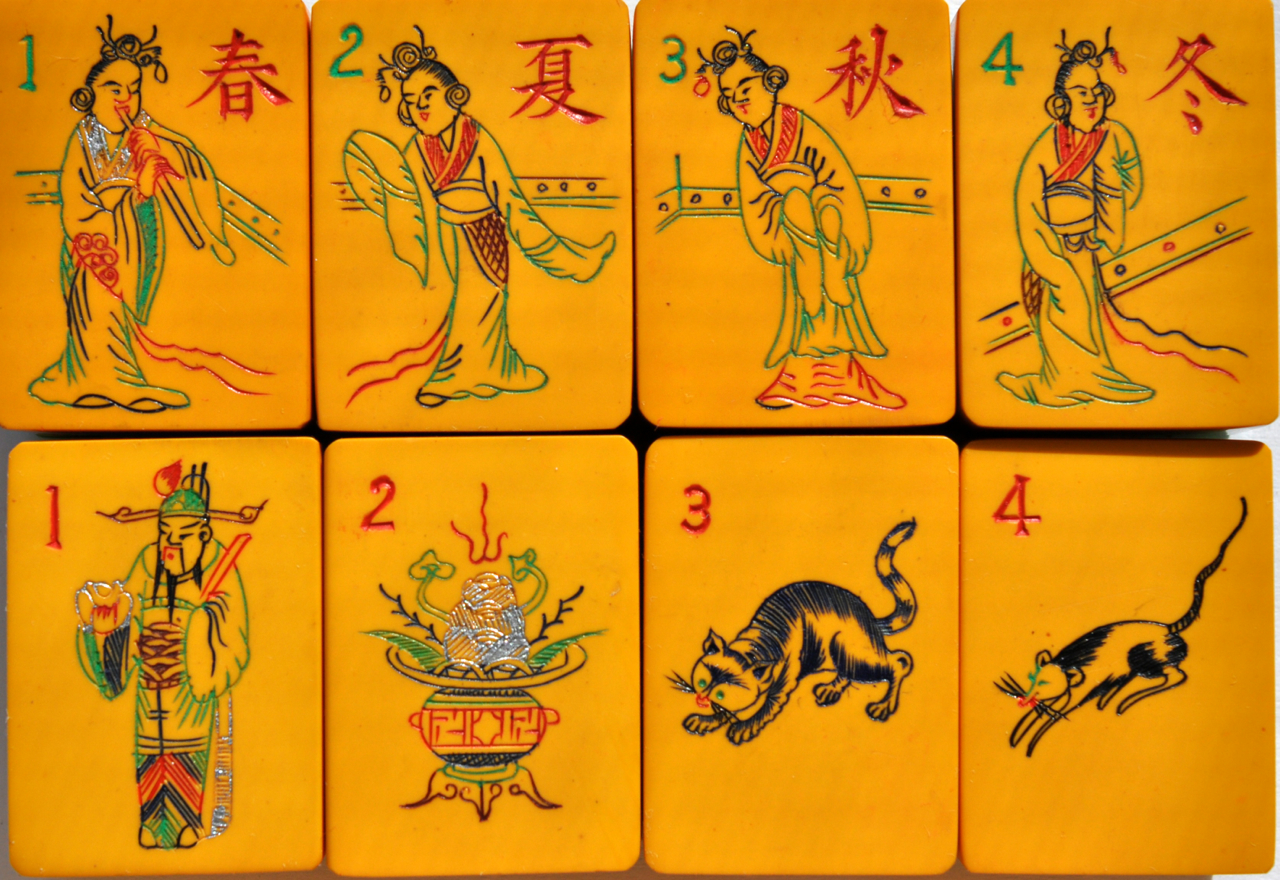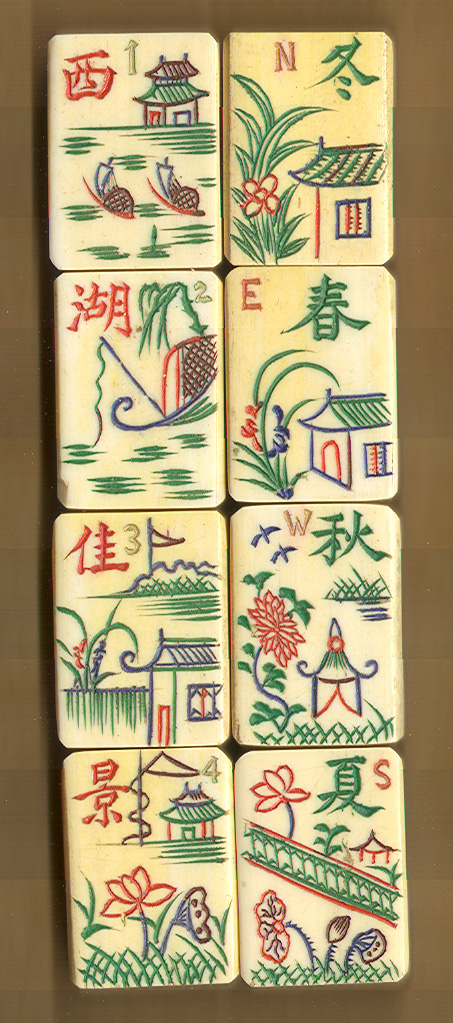At the bottom of this post you will see a link to a new book that was designed to help you identify the type of set you have, and get an idea as to its value.
Many of you may be consulting this website to learn more about a set that you just found, or were just given, or are thinking about parting with.
This article is just to get you familiar with the tiles in your set, and to help you find out if you have a complete set. There is more great information on a couple of other websites, written by two of the people who know the most about the subject, and have been studying Mahjong for years. Both sites are very different, and you can learn a lot on each.
In Mahjong there are three suits: Dots, Bams and Craks, all loosely based on money. Each suit has four of each tile going from 1 to 9. There are also two types of Honor tiles: Dragons (Red, Green and White, four of each), and Winds East South West and North, once again, with four of each.
There are also Flowers. Some sets designed for certain types of Asian play don't even need them, and thus will have only 136 tiles. Other sets typically will have eight Flowers, although the number can vary.
And if you play National Mah Jongg League rules you will need eight more matching tiles for Jokers.
Let's start at the beginning, with what to look for.
Dots, whose round shape is based on a Chinese coin which had a hole in its center:
(This image from primal trek)
On many Dots (or Circles as known in England) you will see some kind of circle, which may have a flower center
Here we have a flower surrounded by partial flowers. Other Dots may continue the flower theme, or may morph into circles:
You can see by the tiles above how varied Dots can be, and how at times they shift from one type of center to another.
On the Bamboo suit, (sometimes known as rods, strings of cash, seed bams depending on the shape of the Bam) we have a suit based on a string of coins. The Chinese carried coins on strings, kept together by a string through the center.
This photo from Village Life in China by Arthur H. Smith
Bamboos can look like this:
simple rods
"barbed" bamboos from the mahjongmahjong collection
rounded ones from the mahjongmahjong collection
"seed bams" (curved Bams) (photo from ebay) (note there are no Arabic numbers on the Bams)
Craks, or Characters in England, are called this because often they had no Western indices (no Arabic numbers or Western letters, only Chinese numbers and the Chinese Character for 10,000 (Crak is an abbreviation of Character) which can be seen in several different ways:
Here you can see an elaborate red Wan, the symbol for 10,000. The above set was not intended for export, thus is lacking any Arabic numbers. Many sets were made like this, intend for the Chinese market. This set fell into the hands of someone not familiar with Chinese numbers who wrote in the more difficult numbers with a pencil. On other sets the added Arabic numbers have been lightly carved.
The above set from mahjongmahjong's collection, and the Arabic numbers are part of the tile, thus the set could easily be exported.
On the above set it looks like the design of the tile intended to have the Arabic numbers. Sometimes those numbers were just squeezed in, onto a tile not originally intend for export.
Wans can take the simple form too:
These very simple somewhat angular ones from mahjongmahjong
the above more slightly rounded ones
or more like these more squared ones:
There are also many types of White, Red and Green Dragons
Oftentimes the White Dragons are simple frames.
Examples of White Dragons include:
and
in Chinese Bakelite
This
in bone and bamboo
along with this plain one:
on plain bone dovetailed onto bamboo.
A Pung Chow White Dragon
and a Piroxloid White Dragon with a P for Po (blank or white). A white Dragon can also have B for Bai.
This is an elaborate Chinese Bakelite White Dragon.
Green Dragons can be quite different too.
From Piroxloid , its Green Dragon is similar to Green Dragons on bone and bamboo sets and some bakelite sets.
The Green Dragon with the Chinese Character for phoenix made by the Mah-Jongg Sales Company of America.
The Green Dragon from Pung Chow
contrasts with the Royal Depth Control Dragon. Many Dragons on Bakelite sets feature creature Dragons.
And Red Dragons have different looks to them too:
The original Red Dragon made by the Mah-Jongg Sales Company of America, which actually is the Chinese Character for dragon. The pairing of the phoenix and dragon, (in this case as "Dragons" in the MJSA sets) was considered very lucky by the Chinese..
This symbol, looking a bit like a sword, is the symbol for Center, which also means China. The C stands for Chung. Often tiles will not have the letter C, and merely the red character.
Of course this is the Red Dragon from Pung Chow
And now for the News! But only players of NMJL rules and perhaps a few others think of the Winds in that way.
These are from a Chinese Bakelite set,
and they are fairly typical.
The "handwriting" on these tiles is a bit unusual, as is the other carving on the set. Nevertheless, they are Winds.
These Winds are very elaborate, and lack the Western indices which make play easier for many of us; many of us would have a hard time at first reading these tiles, but if you can learn the letters, you can play with a lot more sets!
And now to the Flowers.
There are typically eight Flowers, but they can number from four to 24 (in the early 1950s), but most typically there are eight. Actually, the number of matching Flowers in a complete and original set can help date a set.
Flowers often have Arabic numbers on them, going from 1 to 4, with Chinese words in red on one set, and green on another. It's the color of the Chinese words that can help you as you organize your tiles.
above with Red words
and here with green.
Here you see two groups of tiles, from one set, arranged according to color. You will note that the bottom 3 is probably a peach, and the top 3 is Bamboo; so, not necessarily flowers, but Flowers nevertheless.
But Flowers can also be forms of transportation:
These are from an early Mah-Jongg Sales Company of America set.
Or buildings:
from the same MJSA set.
At this point you may have noticed the tiles on this set, both Green and Red, seem to have aspects that continue from one to the next, including the background, mountains, and the river. On these tiles it does not really make a difference if you lay them down 1234 or 4321, the way the Chinese would. But because many of us don't necessarily know about the possible links between tiles, we miss things:
Each tile is half a boat. If you did not place them in Chinese order, you would not know they are related.
The Chinese Bakelite tiles above are an example of a leisure set. If you did not have the tiles in the right order you would miss the ladies playing tennis against each other, and the pool side action.
Flowers can be people in clothes from long ago:
and here
The tiles just above are from a beloved Chinese story: The Ruse of the Empty City. You will often see this sort of set on bone and bamboo tiles.
The two sets of tiles above show two different types of Flower tiles:
The top ones show ladies dancing. (You will quickly see these have been arranged the wrong way!! They should have been laid down 4321, and then the wall would have matched up nicely. ) Ladies with long sleeves, doing the long sleeve dance, are a frequent theme on Flower tiles.
The bottom set are known as Singapore Capture tiles. The Rich Man on the left gets the Pot of Gold, and the cat gets the mouse. Sometimes there will be a fisherman and a fish, and a rooster and a centipede.
Flowers can also be children, musicians, abstract designs representing the four arts of the scholar, the four noble professions, etc. It often seemed the only design limitations were in the minds of the craftsmen.
By this point, you are understanding the principles behind figuring out what types of tiles you have. Don't get tripped up by this:
These are Pung Chow Flower tiles. Notice there is only one tile with each Wind Symbol.
These are beautiful tiles from the mahjongmahjong collection. But don't let yourself get fooled. There is only one kind of Wind, and thus these tiles belong to the Flower family.
For more views of the wonderful sets at the mahjongmahjong collection click here
So, you now have an understanding of what to look for, but you think you may be missing an essential tile. You may be in better shape than you think; you may have a tile that is original to the set but that has been covered over by stickers, so that the tile hiding underneath is still unknown. It just may be what you are looking for, often a Flower, in fact. Through the years, the National Mah Jongg League changed the number of Flowers needed for play (as well as what the Flowers did, because Flowers did serve as jokers or wild tiles for some years). Many people hid Flowers, and the blank tiles that came with the set, under stickers to turn them into Jokers. (If you find a blank tile, and you are missing a tile, that blank can come in handy: you can get it carved to fit in with the other tiles, or even sticker it over, a much simpler and less expensive option.) So, peel off the sticker, particularly if it looks like it has been there for a really long time, and then you will have a sense of what you have and what you need. You may have a complete set after all. And if not, you can look for help here.
The resources list can also help you get extra tiles for jokers, if you need them.
Here is a new book, designed to help you identify your set and to get a feeling about what it might be worth.
To learn more about the book, click below:

